Catalogue > Liste par artiste
Parcourez la liste complète des artistes présentés dans le cadre des Rencontres Internationales depuis 2004. Utilisez le filtre alphabétique pour affiner vos recherches.
Pascal Piron, Karolina Markiewicz
Catalogue : 2023Metamorphosis | VR expérimental | 4k | couleur | 24:0 | Luxembourg | 2021
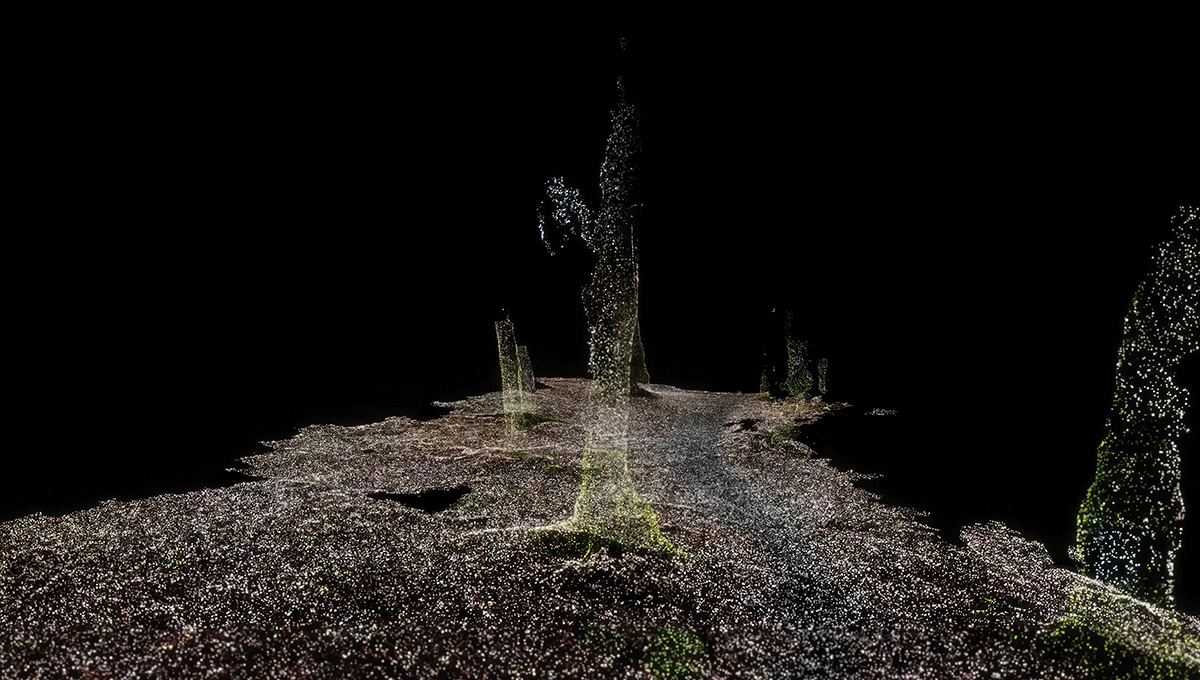
Pascal Piron, Karolina Markiewicz
Metamorphosis
VR expérimental | 4k | couleur | 24:0 | Luxembourg | 2021
METAMORPHOSIS is a location based experience in virtual reality. It thematises the state of fear, astonishment and need for human exchange, as well as the the new comprehension and the physical reduction of the world during an ontological rupture such as the Coronavirus pandemic. In History (from the Antique with the first plague to Modern times with the Spanish flu) every kind of epidemic or pandemic has brought significant changes in societies, people had to adapt and reinvent their lives exchanging as they could. The experience refers to this kind of societal metamorphosis that imply on one hand the awareness of a reduced and different environment as well as related to the exchange of different ideas about the future . For METAMORPHOSIS, different nature and urban places (outside and inside) have been scanned and recreated as 3D scenes in a point cloud aesthetic. These eight scenes form a large corridor that brings the visitor slowly through different stories and ideas. From naive, stunned to more elaborate projections about the future of existence.
Since 2013 Karolina Markiewicz (born in 1976 in Luxembourg, lives and works in Luxembourg) and Pascal Piron (born in 1981 in Luxembourg, lives and works in Luxembourg) have been developing a collaborative body of work that stretches across cinema, visual arts and theatre. At its centre lies the individual as part of the human community, torn between resignation and hope. In their poetically charged investigations, the two artists question contemporary myths and construct metaphorical narratives based on past events.
Catalogue : 2020Fever | VR expérimental | 0 | couleur | 8:0 | Luxembourg | 2019
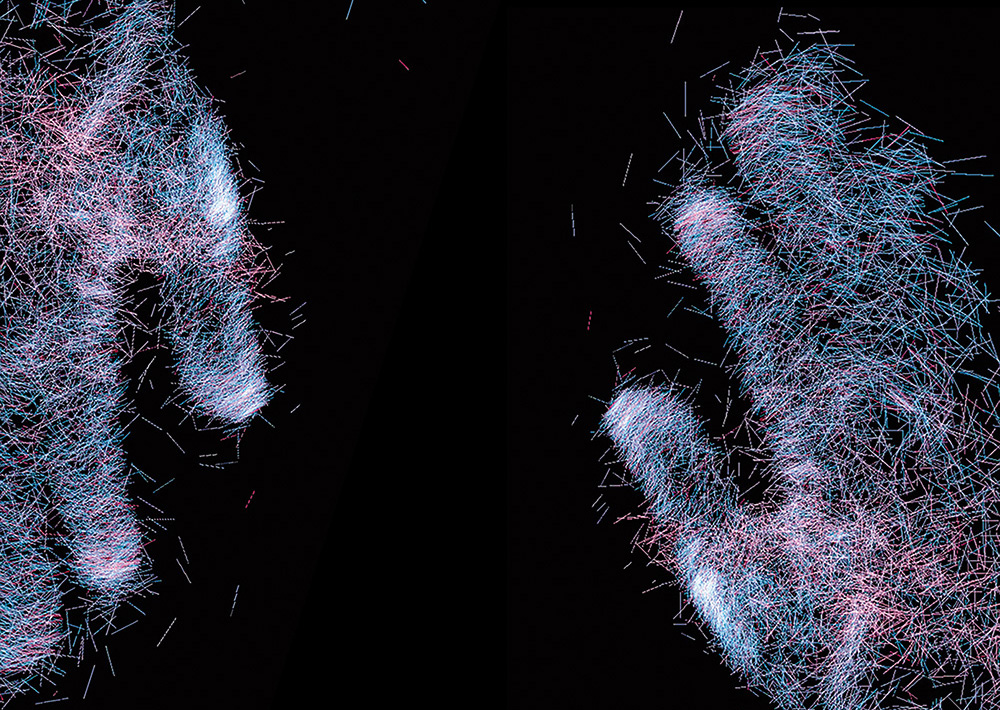
Pascal Piron, Karolina Markiewicz
Fever
VR expérimental | 0 | couleur | 8:0 | Luxembourg | 2019
FEVER (8-10 minutes) is an experience in virtual reality. For both adults and children, a high fever can mean hallucinations — mainly auditory and visual, lucid and in dreams. As a VR experience, FEVER refers to this brief hallucinatory state, acknowledging and interpreting the metaphysical process that occurs when one is within and yet removed from one’s own body, and the limits presented herein vis-à-vis body/environment and self/other. FEVER is also a virtual poem about illness and body fictions. FEVER is written and created by Karolina Markiewicz and Pascal Piron, in technical collaboration with Fabrizio Palmas, Antoine Thiry and Stefan Laimer (D). The music is created by Kevin Muhlen (L) joined by the voice of Ásta Fanney Sigurdardottir (IS) and by the narration of Elisabet Johannesdottir (L/IS).
Karolina Markiewicz and Pascal Piron’s collaborative work creates links between film, visual arts and theatre. At the center is the individual person as part of a human community, oscillating between resignation and hope. Karolina studied political science, philosophy and theatre and works as a film and theatre director. Pascal studied visual arts and works as an artist and film director. Both work also as teachers. They are currently working on several cinematographic and artistic projects. Sublimation – an interactive installation based dance interactive VR piece with butoh dancer Yuko Kominami, was part of College Biennale Cinema VR by the Mostra di Venezia in 2019 and had its premiere at the festival. The duo also works on My Identity is this expanse!, a location based VR piece on exile and resilience through poetry. The Living Witnesses, a feature documentary about anti-Semitism is currently in post-production and will be released this year.
Catalogue : 2019Europe in Autumn - Polish Family | Doc. expérimental | hdv | couleur | 8:41 | Luxembourg | 2018
Pascal Piron, Karolina MARKIEWICZ
Europe in Autumn - Polish Family
Doc. expérimental | hdv | couleur | 8:41 | Luxembourg | 2018
Europa im Herbst - Polska Rodzinka (Europe in Autumn - Polish family) is a short portrait of a tormented Poland, a tormented and conflicted Europe in 2018. Not only populists raise their brutal voices but also right extremists reappear in a very quick rhythm like in the 30s. This experimental short documentary is the result of a journey through Poland where several families co-exist and argue: our own family, the one of the anti-fascist and pro-European protesters, the one of the police, the one of the musicians... The last ones reinterpret old pre-Second World War songs, written by polish Jews, in which people dance and die. Europa im Herbst - Polska Rodzinka is a short merry-go-round ride of our stay in Poland and in Europe in the summer of 2018.
Karolina Markiewicz and Pascal Piron's collaborative work creates links between film, visual arts and theatre. At the center is the individual person as part of a human community, oscillating between resignation and hope. Karolina studied political science, philosophy and theatre and works as a film and theatre director. Pascal studied visual arts and works as an artist and film director. Both work also as teachers. They are currently working on several cinematographic projects. Sublimation "an interactive installation based dance VR piece developed in collaboration with Yuko Kominami" butoh dancer, this project is selected among 12 international projects by the Mostra di Venezia for the the festival and the College Biennale Cinema VR. The duo works also on My Identity is this expanse! an installative VR piece on exile and resilience through poetry and The Living Witnesses, a documentary about anti-Semitism. Their former short films and films: Les Formidables, 2013 Mos Stellarium, 2015 - selected for the 56. Biennale di Venezia di Arte to represent Liechtenstein Side Effects of Reality (2016 - ongoing) - a series of short films on history and contemporary myths: De Rerum Natura, Artis, Kostas, Okopowa-Warszawa, La Figurine, Eos+Aeneas, To not be destroy by powder to the powder and the fist, Here Be Dragons, Europa im Herbst - Polska rodzinka.
Catalogue : 2018Okopowa, Warszawa | Film expérimental | hdv | couleur | 7:16 | Luxembourg | 2017
Pascal Piron, Karolina Markiewicz
Okopowa, Warszawa
Film expérimental | hdv | couleur | 7:16 | Luxembourg | 2017
Among the insurgents of Warsaw, there is Kazia. A young Jewish woman whom the Nazis ended up killing. She now wanders in the cellars of the old ghetto, the Jewish cemetery, on Okopowa Street and tells bits of her memories. Memories that haunt.
Karolina Markiewicz (1976, Luxembourg) and Pascal Piron (1981, Luxembourg) work as an artist duo since 2013. Their collaborative work creates links between film, visual arts and theatre. At the center is the individual person as part of a human community, oscillating between resignation and hope. Karolina Markiewicz studied political science, philosophy and theatre and works as a film and theatre director. Pascal Piron studied visual arts and works as an artist and film director. Both work as teachers.
Catalogue : 2017Artis | Vidéo | hdv | couleur | 5:12 | Luxembourg, Pays-Bas | 2016
Pascal Piron, Karolina Markiewicz
Artis
Vidéo | hdv | couleur | 5:12 | Luxembourg, Pays-Bas | 2016
In Amsterdam, there once was a zoo, lions, elephants, people and Nazis. The elephants, who never forget, tell the story to the young lions. During the Second World War, the story goes, eighteen Jews hid above the lion’s cages. The Nazis, who loved the zoo, cared about the lions and bought them the best meat, usually lamb. The old lions couldn’t eat all they were given, so they left some of it to their new “roommates” for three years.
Karolina Markiewicz and Pascal Piron’s collaborative work creates links between film, visual arts and theatre. At the center is the individual person as part of a human community, oscillating between resignation and hope. Karolina Markiewicz studied political science, philosophy and theatre and works as a film and theatre director. Pascal Piron studied visual arts and works as an artist and film director. Both work as teachers. Their cooperation started in 2013, with an exhibition for Aica Luxembourg entitled Everybody should have the right to die in an expensive car. In 2014, they made a first documentary called Les Formidables, which tells the story of five young migrants in Luxembourg. In 2014, they found the video blog kulturstruktur.com. In 2015 they worked on the project Philoktet, which includes the homonymous play by Heiner Müller and an exhibition relating the Greek tragedy to Robert Oppenheimer and the atomic bomb. At the same time they released their second documentary Mos Stellarium, produced by Tarantula and supported by Film Fund Luxembourg. Part of this project is the installation of Mos Stellarium, which offers different parts of the movie simultaneously, thus giving a non-linear reading of the film. Their current work includes a video series entitled Side-effects of reality. It consists in a number of short films and video installations. Our reality is a vague and imprecise thing, hardly accessible. The core idea of Side-effects of Reality is to push this inaccessible reality to a poetic level, thus creating through video and text a new image of reality. This image is not the same as its content, it has its own mythology, and by this offers a different take on understanding our reality.
Catalogue : 2015Les Formidables | Documentaire | hdv | couleur | 29:51 | Luxembourg | 2014
Pascal Piron, Karolina Markiewicz
Les Formidables
Documentaire | hdv | couleur | 29:51 | Luxembourg | 2014
Documentaire sous forme d`extraits de témoignages autour des peurs et des angoisses de cinq jeunes. Quatre d`entre eux sont demandeurs d`asile et doivent conserver l`anonymat (prénoms d`emprunt). Ils ont entre 18 et 21 ans et ont tous endossé les enjeux de la vie d`adulte. Par hasard, ça se passe au Luxembourg. Il y a plus de 90 nationalités différentes qui se croisent, au Luxembourg, dans nos écoles, nos lycées, nos foyers, avec toutes ces histoires bien particulières : de guerre, d’après-guerre, de manque d’argent, d’exil. Ce sont ces couloirs des exilés auxquels fait référence le sociologue français, Michel Agier. Le documentaire, en trois chapitres donne la place à quelques uns de ces couloirs - quelques uns de ces récits.
Karolina Markiewicz (1976), diplômée en sciences politiques, philosophie et théâtre, et Pascal Piron (1981) diplômé en arts plastiques, travaillent tous deux dans l’enseignement au Luxembourg. Parallèlement, ils développent des travaux artistiques (peinture pour Pascal et mise en scène et écriture pour Karolina) - indépendamment jusqu’en 2013, où démarre leur parcours commun avec l’exposition Everybody should have the right to die in an expensive car réalisée pour le Kiosk de l`Aica Luxembourg. La collaboration qui en découlera permettra aux deux d’envisager leurs travaux artistiques différemment. Pascal ne verra plus l’image de façon bidimensionnelle et reprendra des travaux portée sur la vidéo, quant à Karolina, elle se tournera vers un théâtre d’images, plus abstrait. Tous deux s’intéressent désormais à l’image comme trace qui évolue dans le temps. Ainsi, les travaux s`axent autour de l`installation, la vidéo, du théâtre et des arts plastiques. Plusieurs projets en découlent, notamment le documentaire Les Formidables ainsi que Kulturstuktur /audio+video blog (le projet d’entretiens). Ces projets observent l`individu comme faisant partie d’une communauté humaine, quelque peu résignante d`apparence, mais qui aux travers de certains événements ou objets: film, œuvre d`art, pièce de théâtre, réalisation architecturale ou composition musicale, s`avère être lucide et forte.
Leonardo Pirondi
Catalogue : 2023Visão do Paraíso | Doc. expérimental | 16mm | couleur et n&b | 16:0 | Brésil, Royaume-Uni | 2022
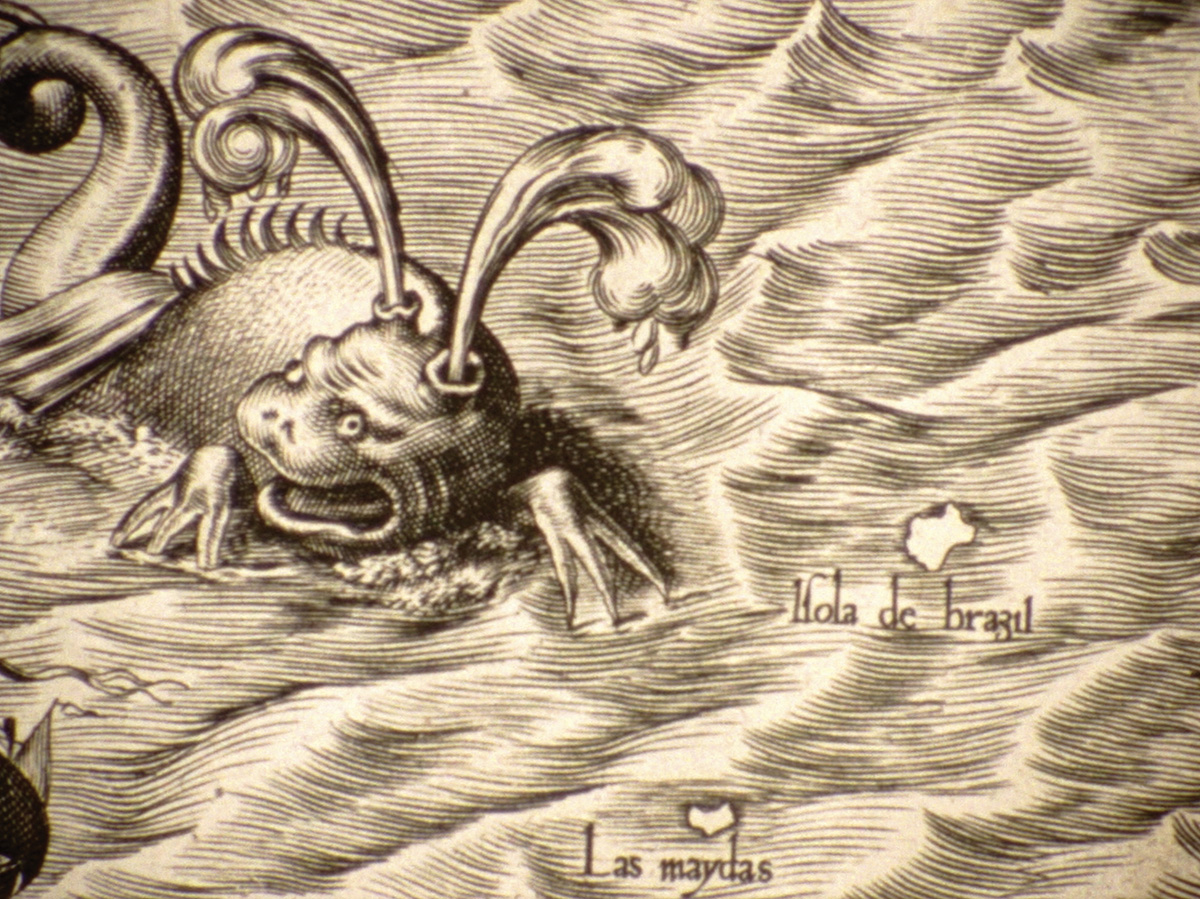
Leonardo Pirondi
Visão do Paraíso
Doc. expérimental | 16mm | couleur et n&b | 16:0 | Brésil, Royaume-Uni | 2022
The great voyages to the "New World" were seen as expanding the frontiers of the visible and displacing those of the invisible. Therefore maps from that time render the real and imaginary. The film follows a voyage of the Brazilian Military in search of an imaginary island with the same name as their country. In the myth from 1483 Brazil, or Hy-Brazil, is known to exist to the west of Ireland and above the Fortunate Islands. ‘Visão do Paraíso’ is an examination of the capacity of the human imagination and computer simulations to construct environments. Amidst the fine threshold of the real, simulated, and imagined, the film analyzes the contemporary ideas of virtual reality and their ambition to expand the frontiers of the physical world into a "New World."
Leonardo Pirondi is a Brazilian filmmaker based in Los Angeles, São Paulo, and Porto. His films explore the infinite abyss between the multiple derived versions of reality through documentary, experimental, and narrative modes. Much of his work uses analog and digital manipulations on celluloid to examine the sociopolitical unfoldings of the intersections between imagination, science, myth, and technology. His films have been exhibited at various film festivals, institutions, and venues internationally, such as the International Film Festival Rotterdam, New York Film Festival, BFI London, Melbourne, Edinburgh, True/False, Ambulante, Curtas Vila do Conde, Guanajuato, Wexner Center, REDCAT, and others. Some of his work exists in the collection of Cinematheque of the Museum of Modern Art in Rio de Janeiro and The Film-Makers' Cooperative in New York. He holds a Film/Video degree from CalArts, is a Sundance Ignite Fellow, and is the recipient of the Allan Sekula Social Documentary Fund and the Tim Disney Prize for Excellence in the Storytelling Arts.
Piscine, Bergman & Salinas
Catalogue : 2019Be A Pattern For The World | Vidéo | hdv | couleur | 5:48 | Danemark | 2018
Piscine, Bergman & Salinas
Be A Pattern For The World
Vidéo | hdv | couleur | 5:48 | Danemark | 2018
Be a Pattern for the World is acollaboration between artist group Piscine (consisting of Mark Tholander, Jens Settergren & Ida Thorhauge) and the artist duo Aeron Bergman & Alejandra Salinas. Be a Pattern for the World circulates around the concept of the chameleon. The chameleon as an abstract machine: "The chameleon, maybe. It hovers, as a turbine. An object can be monitored better by the turbine. These days anything can be imitated." The chameleon most of all stands for shape-shifting and adaptability. Adapting patterns of a given environment, while at the same time creating new patterns in the given space. The ability of changing one's appearance as a response to one's surroundings. What can be seen and what cannot; blending in and standing out; becoming distinct while also becoming part of the given space. The chameleon is the abstract machine which initiates a production of subjectivity in the relation between the individual and the surroundings, the figure and the background, the shape and the pattern, as well as the singular and the univocal.
Piscine is an exhibition phenomenon that handles solo, group and collaborative situations: a hybrid apparatus that sometimes acts as an artist group and at other times acts as a curatorial unit. Current members are: Mark Tholander, Ida Sønder Thorhauge, and Jens Settergren. Aeron Bergman and Alejandra Salinas are an artist duo who co-founded Institute for New Connotative Action: an artist run initiative, and INCA Press.
Bojana Piskur
Catalogue : 2007Ljubljana Modern Art Museum | 0 | 0 | | 0:0 | Slovénie | 2007
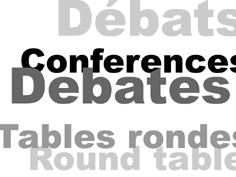
Bojana Piskur
Ljubljana Modern Art Museum
0 | 0 | | 0:0 | Slovénie | 2007
La Moderna Galerija (Musée d?Art Moderne) est l?institution nationale slovène pour l?art moderne et contemporain. Un musée qui a une double vocation, explorer et présenter l?art moderne slovène et sa tradition depuis le début du XXème siècle, explorer et exposer l?art contemporain, sa pratique et son contexte. Situé dans la ville de Ljubljana, la capitale de la Slovénie, La Moderna Galerija opère sur trois sites différents, un bâtiment principal, la Moderna Galerija proprement dite, une ancienne caserne de l?Armée Yougoslave, le Metelkova et la Mala Galerija. Une telle organisation, une telle délocalisation géographique, permet à la Moderna Galerija de spécialiser chaque bâtiment. Le Metelkova est un haut lieu de la culture alternative slovène. La Mala Galerija est un espace d?innovation où sont réalisées des expositions personnelles. Quand au bâtiment principal, il héberge la collection permanente du musée, des expositions temporaires, une bibliothèque et un centre de formation. La Moderna Galerija se voit comme un intermédiaire entre le national et l?international, entre local et global. Un lieu où se cristallise les réalités de la société moderne, à mi-chemin entre les différentes réalités géopolitiques et culturelles de l?Europe contemporaine, entre Est et Ouest, entre Nord et Sud.
Née en 1970, Bojana Pi?kur a étudié à la Faculté de Philosophie de l?Université de Ljubljana, en Slovénie, et à la Charles University de Prague, en République Tchèque, où elle obtenu un PhD en Théorie Artistique. Elle est commissaire d?exposition à la Moderna Galerija, le Musée d?Art Moderne de Ljubljana et elle effectue des recherches sur le phénomène de l?art contemporain.
Alexandros Pissourios
Catalogue : 2025A full life, I suppose. | Doc. expérimental | 16mm | couleur | 25:0 | Chypre | 2023

Alexandros Pissourios
A full life, I suppose.
Doc. expérimental | 16mm | couleur | 25:0 | Chypre | 2023
A full life, I suppose is a filmic portrait of the time shared between the filmmaker and his mother, Androulla, combining new 16mm material shot during his recurring visits to Cyprus with Super 8mm footage shot by his father in the 1970s to chronicle the evolution of bodies and the desires that mark a life. Attempting to balance between observation and construction, the film captures dailiness and domesticity while transfiguring Androulla’s body and inhabited space through close-ups, double exposures and time-lapses. As fragments of conversations between filmmaker and mother about her life wander mostly sync-free over the images, encounters with light and darkness in the nooks and furnishings of her otherwise ordinary dwelling arouse a sense of unreality.
Born in 1982 in Limassol, Cyprus, Alexandros Pissourios lives and works London and Cyprus. Pissourios explores the possibilities inherent with 16mm film and cameras, blending ethnographic approaches with experimental cinema. Many of his films make use of people and places that are in his proximity, weaving a a body of work that explores the complexities of relating to the world around him. Selected screenings/exhibitions of his films include London Short Film Festival (2024), FilmDairy NYC (2024), Annual Copenhagen Film Festival (2024), Lemesos International Documentary Festival (2023/2020), Cubitt Gallery London (2023), Queerwave festival (2023), Supernormal Festival (2017), International Ankara Film Festival (2016) ICA/Lux Moving image Biennial (2012), Fringe! Film Festival (2012), London Gay & Lesbian Film Festival (2011)
Marianne Pistone, Gilles DEROO
Catalogue : 2010Hiver (les grands chats) | Fiction | 16mm | couleur | 55:0 | France | 2008
Marianne Pistone, Gilles DEROO
Hiver (les grands chats)
Fiction | 16mm | couleur | 55:0 | France | 2008
Les enfants s?en tapent de l?hiver qui arrive A se marrer sous les grands chats, à s?embrasser Sous de pauvres abris Il fera nuit de plus en plus tôt L`hiver tombé comme une sentence, Ça y?est faut allumer. J?aurais voulu que Mimi soit intact, rien n?aurait dû l?atteindre... Ni l?hiver.
Marianne Pistone et Gilles Deroo Vivent et travaillent à lille
Robert Harding Pittman
Luis Pizarro Pérez
Catalogue : 2020Yutupis | Documentaire | hdv | couleur | 46:55 | Pérou | 2019
Luis Pizarro PÉrez
Yutupis
Documentaire | hdv | couleur | 46:55 | Pérou | 2019
Yutupis starts off with the filmmaker undertaking a ritual. It evokes images, memories of a village in the Peruvian rainforest. From felling trees and fishing during the day to dancing and drinking at night. Influences from the past and contemporary times are clear: the colonization of the 16th century initiated the cross-cultural mixture that is further amplified by the ongoing of globalization.
The director, Luis Pizarro, is originally from Lima, Peru. He studied Communication Science (in Lima) and went to film school (in Ghent, Belgium). He made several short films and contributed (direction, editing, sound) to various productions (short films, documentaries, video clips etc.)
Plasmodium, Bob MILLER, Jim THOMSON
Catalogue : 2006Rethinking the Raven | Création sonore | 0 | | 60:0 | USA | 2004
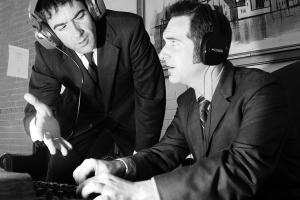
Plasmodium, Bob MILLER, Jim THOMSON
Rethinking the Raven
Création sonore | 0 | | 60:0 | USA | 2004
"In a more Cagean mode, the sound collage "Rethinking the Raven" presents echo-treated field recordings of a suburban smart guy spouting increasingly ridiculous, palsied nonsense syllables into fast-food driveup intercoms. ("Sir, can you drive to the window so we can take your order, we can`t understand you.") The track is funny on a mean spirited Jerky Boys level, but also seductive, with the sound manipulations turning the baffled or bored utterances of the franchise employees into quasi-world music. One clerk`s digitally twinned "I don`t know/I don`t know (I don`t understand what you`re saying)" becomes poignantly melodic through repetition, resembling an eerie call-and-response chant. In "Dr. Octobongopus" a bored lounge MC introduces the stage act of a polyrhythmic, multi-armed, but basically lame bongo player in a routine that is pure deadpan surrealism."
Platoniq, -
Cameron Platter
Catalogue : 2014YOU | Vidéo expérimentale | dv | couleur | 15:59 | Afrique du sud | 2012
Cameron Platter
YOU
Vidéo expérimentale | dv | couleur | 15:59 | Afrique du sud | 2012
A video made up of a collage of Pastor Chris Oyakhilome?s sermon on the ?Power of Thoughts? as well as use sources such penis extension advertisements, visionary fast food chicken outlets, sex websites, eternal happiness, instant cash, waterfalls, abdominal machines, life solutions international, dancing dolphins, mass builder, fireworks, slogans, sub-tropical bondage, and celestial landscapes; all directed in my crude, minimalist filmic technique. The video should be viewed as an expanded, absurdist, collage; part documentary and part commentary.
Cameron Platter was born in 1978, Johannesburg. Recent exhibitions include ?Imaginary Fact, Contemporary South African Art and the Archive?, 55th Venice Biennale; ?Impressions from South Africa, 1965 to Now,? Museum of Modern Art, New York; Le Biennale de Dakar 2010, Dakar, Senegal; ?Coca- Colonization,? Marte Museum, El Salvador; and ?Absent Heroes,? Iziko South African National Gallery. Platter fills the ordinary and marginal, with incendiary new meaning. Working from everyday experience with subjects overlooked or considered delinquent, sordid and lowbrow, he reconnoiters notions and concepts on the outside fringes of South Africa?s popular culture. His work appears in the permanent collection of MoMA, New York; The FRAC des Pays de la Loire, France; and the Iziko South African National Gallery. His work has been highlighted in The New York Times, The Wall Street Journal, Vice Magazine, NKA Journal of Contemporary African Art, Artforum, and Art South Africa.
Catalogue : 2011The Old Fashion | Vidéo | dv | couleur | 16:7 | Afrique du sud | 2010
Cameron Platter
The Old Fashion
Vidéo | dv | couleur | 16:7 | Afrique du sud | 2010
The Old Fashion, is an adventure in humour, love, loss and longing for something more? a mélange of The Third Man, an advertisement for Prince Barrack Hussein?s sports water/ penis combo, strip club dance montages, mysterious villains and co-conspirators, and a certain fast food restaurant on Asstropolis. It pays homage to movie remakes and sequels, franchise food, dumbed-down politics, and mundane beauty. It is a portrait of contemporary South Africa, through the eyes of a deranged cat dictator bent on world domination.
Cameron Platter (born 1978 Johannesburg) His work is an intoxicating vision of Good vs. Evil, documenting contemporary morality through the telling of simple stories drawn and appropriated from the media, TV, films, art, history, pornography, battle scenes, politics, music, and religion. His targets and influences include Lamborghinis, Kawasakis and beautiful women in fishnets; megalomania and the mass media; James Bond and Richard Pryor; corrupt politicians; penis extension machines and strip clubs; children?s stories, crime fiction and gangster films; Southern African woodcut and craft masters; tabloid horror stories; wildlife, real life and things falling apart? Mixing traditional and new mediums, Platter creates a tableau that is a sincere homage to historical themes, an ironical take on contemporary Africa, and an ultra primitive, anti-aesthetic view on what it means to be alive today in South Africa. Recent projects include: Hard Times Great Expectations, Whatiftheworld Gallery, Cape Town; I Am Lonelyness, Hilger Contemporary, Vienna; The Old Fashion, Volta NY, New York; Black Up That White Ass II, Youngblackman, Cape Town; Dak?Art, Biennale de Dakar, 1910-2010: Pierneef to Gugulective, South African National Gallery and Art 39 Basel, Switzerland. His work is included in the permanent collection of the Museum of Modern Art (MoMA) New York.
Michael Poetschko
Catalogue : 2015Zona (Fragment I und II) | Fiction expérimentale | hdv | couleur | 51:16 | Autriche | 2012
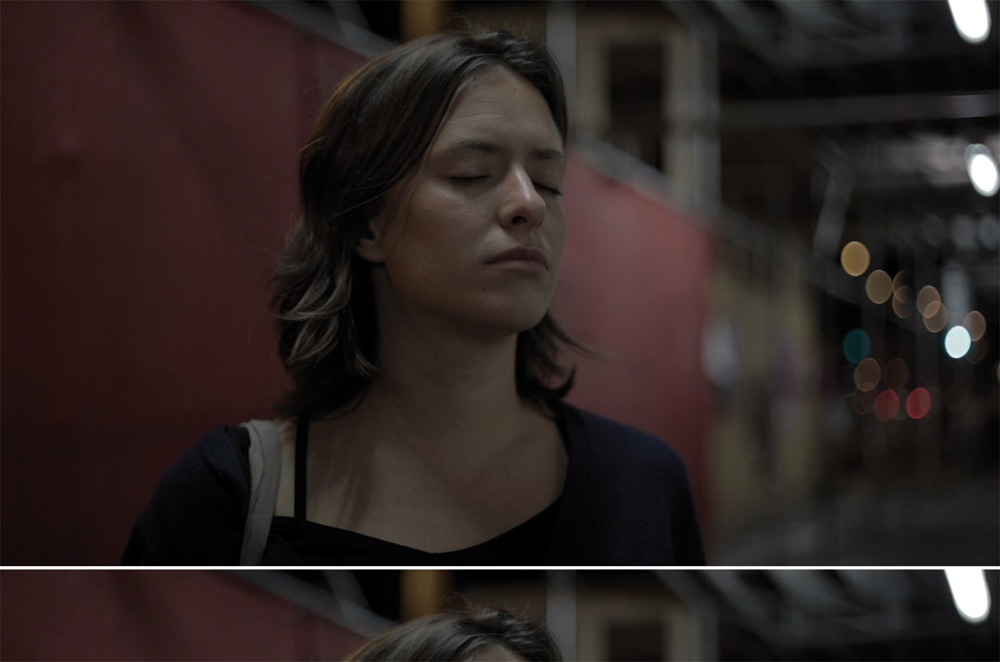
Michael Poetschko
Zona (Fragment I und II)
Fiction expérimentale | hdv | couleur | 51:16 | Autriche | 2012
The topological narrative follows the routes of an itinerant photographer and a young philosophy student, their searching movements in-between the fractures and folds of the spatio-temporal fabric of the contemporary city. These fragments started with a rereading of Andrei Tarkovsky and the brothers Strugacky’s concept of the zone, as depicted in their late 1970s science fiction script Сталкер (Stalker). We suggest that the zone — a structure outside and closed off in Сталкер — has now entered the very heart of the urban fabric. We aim to explore the precarity, porosity and violence of this biopolitical space-time, as an immanent part of the city, our bodies and desires. The narrative presents itself as an open structure, in which staged miniatures, image and sound collages, dialogue, and different searching movements meet each other; open, rampant, unresolved and contradictory — oscillating constantly between poetic meditation and discourse, diversion and gravity, quotation and philosophical speculation.
Michael Poetschko explores narratives of living/laboring/traveling/resisting within post-fordist and transnational realities, working with experimental forms of filmmaking and installation. His work has been exhibited and projected internationally, most recently at the Wexner Center for the Arts in Columbus, the Uferhallen in Berlin and Temp Art Space in New York City.
Sascha Pohle
Catalogue : 2013Reframing the Artist | Vidéo | hdv | couleur | 35:0 | Allemagne, Pays-Bas | 2010
Sascha Pohle
Reframing the Artist
Vidéo | hdv | couleur | 35:0 | Allemagne, Pays-Bas | 2010
REFRAMING THE ARTIST deals with the stereotypical representations of visual artists in movies. The role of the artist both in fictional films and in biopics, classics of the twentieth century or recent popular films, is focused on the artist?s idiosyncratic behavior, his love affairs, his self-destruction associated with a mystification of his creative production or on encounters with other protagonists of the art world such as the collector, the art dealer, the model or the art student. Artists are almost solely painters, which reconfirms a predominant inadequate representation of visual artists in movies. In the video REFRAMING THE ARTIST fragments from approximately 50 different movies such as ?The Moderns? ?Surviving Picasso? or Vincent and Theo? are reset in the Dafen Oil Painting Village. Dafen, situated in Shenzhen, China, is the world`s largest producer of mass-produced handmade oil-on-canvas copy paintings supplying a global market. The video takes place in unmodified settings of the painters` own homes, studios, shops or galleries. There we see Dafen painters re-enacting movie scenes, in which they take over the role of a Picasso, a Van Gogh, a Pollock or several fictional artists, art collectors, critics, muses and lovers. In the ?Reframing the Artist? mass reproduction of oil paintings from Dafen and the recurrent use of artist stereotypes in the mass media film converge to a new narrative overlapping fiction and documentary. The Chinese painter is neither represented as a mere copyist nor does he apply to the notion of the ?original? artist according to our predominant definitions. REFRAMING THE ARTIST raises questions about authenticity in the context of global cultural exchange and it challenges the view of the ?exotic? Other, both the visual artist and the Chinese copy painter. The video is structured into five chapters: Artist and Authenticity, Artist and Market, Artist and Crisis, Artist and Student, Artist and Model. Painting props taken from the same original movies re-appear as copies in REFRAMING THE ARTIST.
Education 2002 B.A. Staatliche Hochschule für Bildende Künste (Städelschule), klasse Ayse Erkmen, Frankfurt am Main, DE 2007 Rijksakademie van beeldende kunsten, NL (Selected) solo exhibitions 2013 Rongwrong, Amsterdam, NL 2012 Art space Apguyeong, open in November en gecureerd door Ji Yoon Yang (De Appel CP 2008/09), Seoul, KR, (aanstaand) (exhibited works: Noire et Blanche + new production) 2012 Lothringer_13_Halle, gecureerd door Felix Ruhöfer, München, DE (exhibited works: Noire et Blanche, Statues Also Die, German Indian, Reframing the Artist, The Mad Masters) 2012 Gallery Weingrüll, Karlsruhe, DE (exhibited works: Noire et Blanche, Reframing the Artist, Statues Also Die) (Selected) group exhibitions 2013 ?Transfer Korea-NRW?, Kunsthalle Düsseldorf and Kunstmuseum Bonn, National Museum of Korea, Arko, (upcoming) - new production: Ornaments of Property 2012 Monitoring/ Kasseler Dokumentarfilm und Videofest, (upcoming), DE - Statues Also Die 2012 ?Generation Loss?, Green Papaya Art Projects, Manila, PHL 2012 ?Signals: For Real?, IFFR, 41st International Film Festival Rotterdam, gecureerd door Edwin Carels, NL - Reframing the Artist 2011 Museum der Moderne Salzburg, ?role models-role playing?, AUT - The Mad Masters 2010 Arti et Amicitae, Amsterdam, ?Villains and Heroes?, Sascha Pohle/Marco Pando, NL - German Indian 2010 Dafen International Contemporary Art Exhibition, ?Convection? Dafen Sub-Venue, Shenzhen Case Pavillion, 2010 Shanghai EXPO, CN - Reframing the Artist 2010 Taipeh International Art Center, Urban Nomad Video Art Section, TW - Reframing the Artist 2010 ?works?, basis, Frankfurt, DE 2008 PARA/SITE art space, ?Terminus?, gecureerd door Christina Li (De Appel CP 2008/09), Hong Kong - The Swimmer 2008 ?Beyond Paradise?, SMBA Stedeljik Museum Bureau Amsterdam, gecureerd door Delphine Bedel and Ayako Yoshimura , NL - The Swimmer 2008 ?Vertrautes Terrain?, ZKM - Center for Art and Media, Karlsruhe, gecureerd door Gregor Jansen and Thomas Thiel - German Indian 2008 Schirn Kunsthalle, Frankfurt am Main, DE, `All-Inclusiv A Tourist World - The Swimmer (Selected) Filmfestivals 2012 BIEFF, Bukarest, RO, Reframing the Artist 2012 58. Internationale Kurzfilmtage Oberhausen, DE, Reframing the Artist 2012 41st International Film Festival Rotterdam, NL, Reframing the Artist 2011 HomeShop, Jue Festival, Beijng, CN, Reframing the Artist 2009 Videonale 12, Bonn, DE, The Mad Masters¬ 2008 International Film Festival, 16th Curtas Vila do Conde, PT, If I were you ? LAS VEGAS NEW YORK BLACKPOOL, The Mad Masters 2008 37th International Filmfestival Rotterdam, NL If I were you ? LAS VEGAS NEW YORK BLACKPOOL Residencies 2006-2007 Rijksakademie van beeldende kunsten/Dutch Ministry of Education, Culture and Science, 2009 Meetfactory, Prague, CZ 2011 Incheon Art Platform, KR 2012 Changdong Studios, Seoul, KR (upcoming) Prices, Awards 2012 Principal Price, 58th International Short Film Festival Oberhausen, for Reframing the Artist, Netherlands, 2010 Fellowships/stipends 2011/12 The Netherlands Film Fund, research subsidy on DVD movie piracy 2011/12 Fonds BKVB, standard werkbudget for Noire et Blanche in combination with a residency in Incheon Art Platform, Korea 2010 Fonds BKVB, werkbudget for Detective project ? The Student of Prague 2009 Fonds BKVB, standard werkbudget for MeetFactory artist residency 2009 The Netherlands Film Fund, NL for Reframing the Artist 2008 Fonds BKVB, basis stipend, NL 2007 Hessische Kulturstiftung, DE, for The Mad Masters and If I were you ? LAS VEGAS NEW YORK BLACKPOOL 2006 DAAD, Berlin, DE 2006 Kunststiftung NRW, DE 2003 Kunststiftung NRW, DE, for Safety Hour 2003 Kulturstiftung Dresden der Dresdner Bank, DE, studio stipend `dynamo.eintracht`
Ben Pointeker
Catalogue : 2018Impassenger | Vidéo expérimentale | hdv | couleur | 6:0 | Autriche | 2017
Ben Pointeker
Impassenger
Vidéo expérimentale | hdv | couleur | 6:0 | Autriche | 2017
Impassenger présente un espace de résonance émotionnelle et, ce faisant, permet au cinéma de devenir haptique. Ce film explore la relation entre la proximité et la distance, et permet à l’objet de l’enquête de figer sa soumission.
Ben Pointeker is a visual artist and filmmaker based in Vienna. His work often sets in between film and photography and is concerned with poetics, patterns of narrative cinema, the notion of time, ambiguous realities and fantasy. Previously based in The Netherlands he graduated from Piet Zwart Institute and won the Prix de Rome basic award. He is also a graduate of the University of applied arts Vienna and was artist in residence at Wiels in Brussels, in Shanghai and most recently at Bòlit in Girona in the framework of The Spur. He has exhibited at institutions such as Secession Vienna, Kunstpavillon Innsbruck, Contemporary Art Center Vilnius, Filmmuseum Amsterdam and major film festivals.
Catalogue : 2008. ..... .:.:...:::ccccoCCoooo:: | Film expérimental | dv | couleur | 9:30 | Autriche | 2006
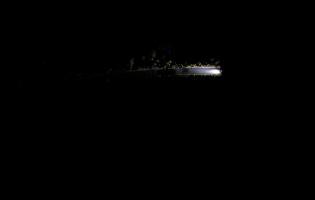
Ben Pointeker
. ..... .:.:...:::ccccoCCoooo::
Film expérimental | dv | couleur | 9:30 | Autriche | 2006
Solution bien pratique au problème de l?orientation dans une salle de théâtre ou de cinéma, de petites lampes dissimulées ça et là montrent aux gens où mettre les pieds et où ne pas les mettre, leur indiquant leur fauteuil ou la sortie. Imagine maintenant l?obscurité totale. Entre. Arrête d?imaginer et regarde . ..... .:.:...:::ccccoCCoooo:: Alors qu?on regarde, la question se pose de ce que c´est regarder. Les petites balises de guidage nous reviennent à l?esprit. D?habitude, c?est en regardant que nous nous orientons. En réaction à cela, ou peut-être par conséquence, maintes formes d?art se proposent de nous désorienter. Mais la question de l?essence même du « regard » reste sans réponse. Or cette question est au centre de l??uvre de Ben Pointeker. Pour y répondre, tout en gardant ses distances vis-à-vis du langage conventionnel du cinéma et de la photographie, il renoue néanmoins avec celui-ci. La manière dont il procède rappelle la poésie concrète. Mais il ne s?agit ici que d?une réminiscence. La poésie concrète n?était dans l?ensemble qu?une réaction à quelque chose d?autre : ce que nous connaissions déjà. Et de ce fait, elle était limitée sur le plan dialectique à ce que nous connaissions déjà. Dans son approche cinématographique, Pointeker sait comment sortir de cette ornière. Mais il ne le montre pas. Ce qu?il montre, c?est ce qui apparaît. Nous nous trouvons dans l?obscurité totale. Une lumière brille. Plusieurs lumières brillent : une voiture se fraie son chemin. Au sens littéral du terme : une voiture se fraie son chemin. Cette voiture n?amène personne de A à B. En projetant sa lumière, elle se fraie son propre chemin. D?autres images suivent, qui se fraient leur propre chemin. Nous regardons, captivés par la lumière de ce qu?on nous montre, et nos sens commencent à deviner ce que c´est regarder. (Frans-Willem Korsten)
Ben Ponteker studierte u.a. Literaturwissenschaft und Kunst in Wien, Kopenhagen und Rotterdam, zuletzt MA Fine Art, Piet Zwart Institute Rotterdam; experimentelles Kino und filmische Installationen, Textpublikationen; daneben Bühnenvideos für Theater- und Tanzproduktionen und dramaturgische Beratung; in der Beschäftigung mit suggestiven Bildsphären interessiere ich mich für Rhetorik und Substanz des visuellen Erzählens
Marie Poitevin
Catalogue : 2008Julien Blaine, l'éléphant et la chute | Doc. expérimental | 16mm | couleur | 13:45 | France | 2006
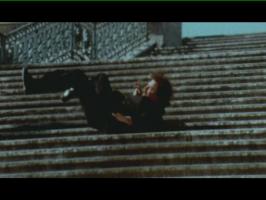
Marie Poitevin
Julien Blaine, l'éléphant et la chute
Doc. expérimental | 16mm | couleur | 13:45 | France | 2006
Julien Blaine est poète « performer » il écrit, il hurle, il agit : « L?acte comme poème. Ce film est une rencontre avec deux de ses performances : « la chute dans les escaliers de la gare Saint Charles » et sa première « l?interview des éléphants. » Ce film est l?interprétation de sa création, de ses actions par sa fille. Ici , elle confronte le passé et le présent, elle invite le spectateur à déchiffrer, à ressentir, à créer du sens.
Après une formation aux Beaux ? Arts de Cergy et une formation aux métiers de l?image à la fémis, j?ai participé en tant que chef opératrice à plusieurs court métrages : Le ravissement de Raphaël Jacoulot ; Enceinte jusqu?aux dents de Marie Donnio ; A bright Interval d?Emilie Lamoine? J?ai été cadreuse sur plusieurs documentaires : Arthur Penn ; Jean François Laguioni, un cinéaste animé de Jean Jacques Bernard pour ciné cinéma classic. Et Résistants de la première Heure de Pholippe Costantini. J?ai réalisé plusieurs films vidéos accompagnant des lectures de poètes : Jacques Sivan et Vanina Maestri. Ainsi que des vidéos pour une compagnie de théâtre Alzhar et des musiciens Diabolicus. J?ai réalisé trois films sur la performance : Last Festival ; Bye bye la perf et ce dernier sur Julien Blaine. J?ai dirigé la lumière pour la compagnie Alzhar à la friche de la belle de mai et pour Diabolicus au théâtre des Bouffes du Nord.
Fernanda Polacow
Catalogue : 2025Big Bang Henda | Doc. expérimental | digital | couleur | 22:0 | Brésil, Portugal | 2023
Fernanda Polacow
Big Bang Henda
Doc. expérimental | digital | couleur | 22:0 | Brésil, Portugal | 2023
Renversant statues et symboles, construisant de nouveaux souvenirs, encadrant le paysage détruit, écrivant des lettres pour l'avenir, inversant les dynamiques de pouvoir : BIG BANG HENDA est un documentaire-poésie-manifeste sur le travail de l'artiste angolais Kiluanji Kia Henda. Il nous emmène dans un voyage à travers ses créations et réflexions, qui sont à l'avant-garde de la pensée anticoloniale, nous exhortant à réfléchir sur la manière dont les générations qui ont grandi pendant ou à la suite de la guerre réinterprètent cet événement.
Fernanda is a screenwriter and director, living between Brazil and Portugal. She has been working in the intersections between Brazil, Portugual and the African Portuguese speaking countries and former colonies of Portugal for decades. Her first feature as a writer, Mosquito, was the opening film at the Rotterdam FF (2020) and won the Critics Prize at the São Paulo International FF (2020) besides touring dozens of festivals. Her second feature, The Last Summer, is currently in production after being selected for the Script Station at Berlinale 2023 and RACCONTI. She has been developing, writing, and directing for TV, streaming and cinema, and some of her works have received awards and nominations at the Brazilian Cinema Academy, New York TV&Film Festival, Hollywood Woman’s FF, among others. She is part of the Torino Film Lab 2023. She is a co-founder of MUTIM, a woman in film association in Portugal.
Wiktor Polak
Catalogue : 2011Blisko | Art vidéo | dv | couleur | 5:49 | Pologne | 2008
Wiktor Polak
Blisko
Art vidéo | dv | couleur | 5:49 | Pologne | 2008
?Blisko? (?Close?) ? about alienation in the big city. The artificial light inside the night trams creates a new reality.
I was born in 1979. Between 1998 and 2004, I studied at the Władysław Strzemiński Academy of Fine Arts in Łódź. In 2004, under the tutelage of prof. Grzegorz Przyborek, I obtained the certificate and title of Master of Fine Arts in asvertising photography. Since 2003, I have also participated in multimedia workshops held by prof. Konrad Kuzyszyn and Łukasz Ogórek, MFA. I was a post-graduate, free participant there. Since that time, my interests hav revolved around film and video. In 2007, I went on a three-month scholarship to France, organised by the Strasbourg Klub, the City of Strasbourg as well as the CAAC.
Esther Polak, Ivar Van Bekkum
Catalogue : 2017A Collision of Sorts | Doc. expérimental | hdv | couleur | 17:0 | Pays-Bas, USA | 2017
Esther Polak, Ivar Van Bekkum
A Collision of Sorts
Doc. expérimental | hdv | couleur | 17:0 | Pays-Bas, USA | 2017
In A Collision of Sorts, inhabitants of the City of Philadelphia, (Pennsylvania, US) go there way, as discontinuous moving dots on a flat surface. The world in which this film plays is Google Earth: an alienating landscape of almost seamlessly stitched-together satellite images of the familiar planet we humans are moving around on. On Google Earth, nothing moves. Buildings, bridges and cars seem warped and flattened and compete for attention with the black weirdness of their own shadows. A virtual camera shows this frozen flattened landscape, reconnoitring the cityscape of the city. Meanwhile we hear sounds and voices. People and animals are down there, crossing the country. It is them who share a physical reality: we hear very intimately their breath, the rustling of clothes, traffic, their vehicles. They travel from one place to another giving the suggestion of a destination. They talk about encounters, visual, economic, political, social and personal but never the main characters seem to meet. Until a bad dream of one of them seems to come true.
Esther Polak and Ivar van Bekkum work together as artist-couple under the name PolakVanBekkum. Routed in the history of the Dutch realistic landscape depiction, they express personal experiences of moving and space. Their projects are often informed by collaborations with participants, be it humans, animals, or even the rays of the sun. Their work has been shown at amongst others: FID Marseille, Transmediale Berlin, Ars Electronica Linz, ZKM Karlsruhe, Media-Lab Prado Madrid; INIVA London, IMAL Brussels, Rento Brattinga | Galerie Amsterdam, Pixelache Helsinki, Lagos, Biennale Marrakech, Philadelphia and Los Angeles. 2016 Special Mention for the film Once We Get There Riga 2015 Expanded Media Preis For Network Culture at Stuttgarter Filmwinters - for “The Mailman’s Bag” 2005 Golden Nica for Interactive Art at Ars Electronica together with Ieva Auzina, with MILKproject. Esther Polak studied at the Rijksakademie for visual Arts in Amsterdam and the Royal Academy of Visual Arts in The Hague, NL Ivar van Bekkum studied journalism at the School for Journalism, Kampen, NL
Catalogue : 2016Once We Get There | Film expérimental | hdv | couleur | 49:50 | Pays-Bas, USA | 2015
Esther Polak, Ivar van Bekkum and Esther Polak
Once We Get There
Film expérimental | hdv | couleur | 49:50 | Pays-Bas, USA | 2015
This film introduces an alienating yet familiar landscape of satellite images, tracks and sound. We follow the minute by minute movements and sounds of animals and machines, the chatting of people in Philadelphia. Although we constantly hear reality, we experience the movements within an abstract, two dimensional world of satellite photography. Without any crew present, the protagonists recorded their trajectories, sounds and private readings of the streets, allowing the filmmakers to access their experiences only afterwards. The film positions the audience as unwitting voyeurs. The meditative approach questions our contemporary techno-society, where social connectivity and eavesdropping coexist and balances between empathic co-traveling and voyeurism. The film resulted from a 7 month “Art in Public Space/Percent For Art” residency of Dutch visual artists Esther Polak and Ivar van Bekkum in Philadelphia.
Esther Polak and Ivar van Bekkum work together under the name PolakVanBekkum. Their work focusses on landscape and mobility. Routed in the history of the Dutch realistic landscape depiction, they engage with new technologies like GPS and data collection, to express individual experiences of spaces like the contemporary city and countryside. They search for changing ways to be in landscapes and how this influences the human understanding of space and the stories we tell to explain our lives. Besides the digital and technological innovative, they use very concrete means of visualisation, like drawings in sand or light, which makes their work very tangible and direct. Their projects are often informed by collaborations with participants, be it humans, objects, or even the rays of the sun. They have worked and exhibited internationally, at Transmediale Berlin, Ars Electronica Linz, ZKM Karlsruhe, London, IMAL Brussels, Rento Btattinga | Gallery Amsterdam, Museo for Image and Sound Sao Paolo, Nairobi, Lagos, Marrakech, Paris, Philadelphia and Los Angeles. In 2005 Esther Polak did receive a Golden Nica for interactive Art at Ars Electronica together with Ieva Auzina, for their MILKproject. Esther Polak is educated at the Rijksacademie in Amsterdam. Ivar van Bekkum is educated as journalist.
Esther Polak, Ivar van Bekkum and Esther Polak
Catalogue : 2017A Collision of Sorts | Doc. expérimental | hdv | couleur | 17:0 | Pays-Bas, USA | 2017
Esther Polak, Ivar Van Bekkum
A Collision of Sorts
Doc. expérimental | hdv | couleur | 17:0 | Pays-Bas, USA | 2017
In A Collision of Sorts, inhabitants of the City of Philadelphia, (Pennsylvania, US) go there way, as discontinuous moving dots on a flat surface. The world in which this film plays is Google Earth: an alienating landscape of almost seamlessly stitched-together satellite images of the familiar planet we humans are moving around on. On Google Earth, nothing moves. Buildings, bridges and cars seem warped and flattened and compete for attention with the black weirdness of their own shadows. A virtual camera shows this frozen flattened landscape, reconnoitring the cityscape of the city. Meanwhile we hear sounds and voices. People and animals are down there, crossing the country. It is them who share a physical reality: we hear very intimately their breath, the rustling of clothes, traffic, their vehicles. They travel from one place to another giving the suggestion of a destination. They talk about encounters, visual, economic, political, social and personal but never the main characters seem to meet. Until a bad dream of one of them seems to come true.
Esther Polak and Ivar van Bekkum work together as artist-couple under the name PolakVanBekkum. Routed in the history of the Dutch realistic landscape depiction, they express personal experiences of moving and space. Their projects are often informed by collaborations with participants, be it humans, animals, or even the rays of the sun. Their work has been shown at amongst others: FID Marseille, Transmediale Berlin, Ars Electronica Linz, ZKM Karlsruhe, Media-Lab Prado Madrid; INIVA London, IMAL Brussels, Rento Brattinga | Galerie Amsterdam, Pixelache Helsinki, Lagos, Biennale Marrakech, Philadelphia and Los Angeles. 2016 Special Mention for the film Once We Get There Riga 2015 Expanded Media Preis For Network Culture at Stuttgarter Filmwinters - for “The Mailman’s Bag” 2005 Golden Nica for Interactive Art at Ars Electronica together with Ieva Auzina, with MILKproject. Esther Polak studied at the Rijksakademie for visual Arts in Amsterdam and the Royal Academy of Visual Arts in The Hague, NL Ivar van Bekkum studied journalism at the School for Journalism, Kampen, NL
Catalogue : 2016Once We Get There | Film expérimental | hdv | couleur | 49:50 | Pays-Bas, USA | 2015
Esther Polak, Ivar van Bekkum and Esther Polak
Once We Get There
Film expérimental | hdv | couleur | 49:50 | Pays-Bas, USA | 2015
This film introduces an alienating yet familiar landscape of satellite images, tracks and sound. We follow the minute by minute movements and sounds of animals and machines, the chatting of people in Philadelphia. Although we constantly hear reality, we experience the movements within an abstract, two dimensional world of satellite photography. Without any crew present, the protagonists recorded their trajectories, sounds and private readings of the streets, allowing the filmmakers to access their experiences only afterwards. The film positions the audience as unwitting voyeurs. The meditative approach questions our contemporary techno-society, where social connectivity and eavesdropping coexist and balances between empathic co-traveling and voyeurism. The film resulted from a 7 month “Art in Public Space/Percent For Art” residency of Dutch visual artists Esther Polak and Ivar van Bekkum in Philadelphia.
Esther Polak and Ivar van Bekkum work together under the name PolakVanBekkum. Their work focusses on landscape and mobility. Routed in the history of the Dutch realistic landscape depiction, they engage with new technologies like GPS and data collection, to express individual experiences of spaces like the contemporary city and countryside. They search for changing ways to be in landscapes and how this influences the human understanding of space and the stories we tell to explain our lives. Besides the digital and technological innovative, they use very concrete means of visualisation, like drawings in sand or light, which makes their work very tangible and direct. Their projects are often informed by collaborations with participants, be it humans, objects, or even the rays of the sun. They have worked and exhibited internationally, at Transmediale Berlin, Ars Electronica Linz, ZKM Karlsruhe, London, IMAL Brussels, Rento Btattinga | Gallery Amsterdam, Museo for Image and Sound Sao Paolo, Nairobi, Lagos, Marrakech, Paris, Philadelphia and Los Angeles. In 2005 Esther Polak did receive a Golden Nica for interactive Art at Ars Electronica together with Ieva Auzina, for their MILKproject. Esther Polak is educated at the Rijksacademie in Amsterdam. Ivar van Bekkum is educated as journalist.
Renata Poljak
Catalogue : 2021Porvenir | Doc. expérimental | 4k | couleur | 12:10 | Croatie | 2020
Renata Poljak
Porvenir
Doc. expérimental | 4k | couleur | 12:10 | Croatie | 2020
Rêvant de terres meilleures, de génération en génération, à cause de la pauvreté, de la faim ou des guerres, nous voyageons sur les mers. La géographie est notre destinée. Nos corps conservent-ils la mémoire de nos grands-pères? Les souvenirs de fugue à la recherche de terres meilleures sont-ils inscrits dans nos corps? "Porvenir" signifie "avenir" en espagnol. Porvenir est aussi la seule ville de la Terre de Feu, au bout du monde, fondée par des immigrants venus de Croatie au début du XXe siècle.
Renata Poljak (née en 1974 à Split, Croatie) est artiste visuelle et cinéaste. Elle a été diplômée de la Arts Academy of the University of Split (Croatie) en 1997, et a obtenu un Master à l'École régionale des Beaux-arts de Nantes(France), département cinéma et vidéo, en 1999. Ses réalisations ont été présentées dans le cadre de nombreuses expositions individuelles et collectives, de biennales et de festivals de cinéma, d’envergure tant nationale qu’internationale. Elle a reçu de nombreuses bourses et récompenses, dont le prix T-HT en 2012 - l'un des plus importants prix d'art contemporain en Croatie. Elle a été artiste en résidence, notamment au San Francisco Art Institute (USA); au Museumquartier, Vienne (Autriche); à Art In General, New York (USA); à la Cité Internationale des Arts, Paris (France); aux Récollets, Paris (France). Ses films ont été projetés notamment au Prospectif cinéma du Centre Pompidou, Paris (France) [2010], et au Palais de Tokyo, Paris (France) [2012].
Ulrich Polster
Catalogue : 2006Frost (I) | Art vidéo | dv | couleur | 5:51 | Allemagne, Russie | 2003
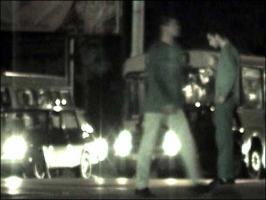
Ulrich Polster
Frost (I)
Art vidéo | dv | couleur | 5:51 | Allemagne, Russie | 2003